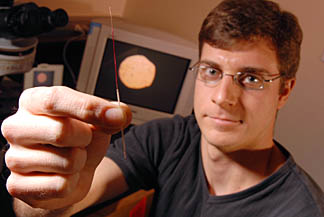 |
| Georgia Tech postdoctoral fellow Jean-Francois Masson holds a microelectrode modified with a biosensing layer capable of measuring adenosine triphosphate (ATP), a chemical involved in energy transport in humans. It’s of interest to medical researchers because elevated levels have been linked with cystic fibrosis, a disease that affects one out of every 2,500 people in the United States. |
Researchers are using an innovative, multifunctional sensing tool to investigate adenosine triphosphate (ATP) release and its role in cystic fibrosis. ATP is a chemical involved in energy transport and is of interest to medical researchers, because when at elevated levels it has been linked with cystic fibrosis, a disease that affects one out of every 2,500 people in the United States.
…
Add new comment